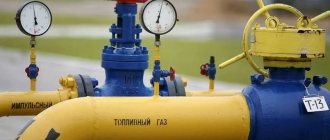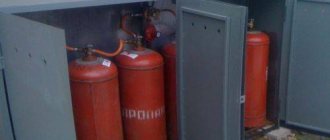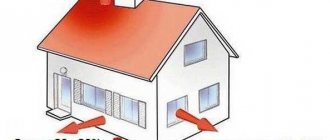Calculation method for natural gas
The approximate gas consumption for heating is calculated based on half the power of the installed boiler. The thing is that when determining the power of a gas boiler, the lowest temperature is set. This is understandable - even when it is very cold outside, the house should be warm.
You can calculate gas consumption for heating yourself
But calculating gas consumption for heating using this maximum figure is completely incorrect - after all, the temperature is generally much higher, which means much less fuel is burned. That’s why it is generally accepted that the average fuel consumption for heating is about 50% of the heat loss or boiler power.
We calculate gas consumption by heat loss
If you don’t have a boiler yet, and you estimate the cost of heating in different ways, you can calculate it from the total heat loss of the building. They are most likely known to you. The technique here is this: they take 50% of the total heat loss, add 10% to provide hot water supply and 10% to remove heat during ventilation. As a result, we obtain the average consumption in kilowatts per hour.
Next, you can find out the fuel consumption per day (multiply by 24 hours), per month (by 30 days), and, if desired, for the entire heating season (multiply by the number of months during which the heating operates). All these figures can be converted into cubic meters (knowing the specific heat of combustion of gas), and then multiply the cubic meters by the price of gas and, thus, find out the heating costs.
| Crowd name | Unit | Specific heat of combustion in kcal | Specific heat of combustion in kW | Specific heat of combustion in MJ |
| Natural gas | 1 m 3 | 8000 kcal | 9.2 kW | 33.5 MJ |
| Liquefied gas | 1 kg | 10800 kcal | 12.5 kW | 45.2 MJ |
| Coal (W=10%) | 1 kg | 6450 kcal | 7.5 kW | 27 MJ |
| Wood pellets | 1 kg | 4100 kcal | 4.7 kW | 17.17 MJ |
| Dried wood (W=20%) | 1 kg | 3400 kcal | 3.9 kW | 14.24 MJ |
Example of heat loss calculation
Let the heat loss of the house be 16 kW/hour. Let's start counting:
- average heat demand per hour - 8 kW/h + 1.6 kW/h + 1.6 kW/h = 11.2 kW/h;
- per day - 11.2 kW * 24 hours = 268.8 kW;
- per month - 268.8 kW * 30 days = 8064 kW.
The actual gas consumption for heating also depends on the type of burner - modulating ones are the most economical
Convert to cubic meters. If we use natural gas, we divide the gas consumption for heating per hour: 11.2 kW/h / 9.3 kW = 1.2 m3/h. In calculations, the figure 9.3 kW is the specific heat capacity of natural gas combustion (available in the table).
By the way, you can also calculate the required amount of fuel of any type - you just need to take the heat capacity for the required fuel.
Since the boiler has not 100% efficiency, but 88-92%, you will have to make further adjustments for this - add about 10% of the obtained figure. In total, we get gas consumption for heating per hour - 1.32 cubic meters per hour. Next you can calculate:
- consumption per day: 1.32 m3 * 24 hours = 28.8 m3/day
- monthly demand: 28.8 m3/day * 30 days = 864 m3/month.
The average consumption for the heating season depends on its duration - multiply by the number of months while the heating season lasts.
This calculation is approximate. In some months, gas consumption will be much less, in the coldest month - more, but on average the figure will be about the same.
Boiler power calculation
The calculations will be a little simpler if you have the calculated boiler power - all the necessary reserves (for hot water supply and ventilation) have already been taken into account. Therefore, we simply take 50% of the calculated capacity and then calculate the consumption per day, month, per season.
For example, the design power of the boiler is 24 kW. To calculate gas consumption for heating, we take half: 12 k/W. This will be the average heat demand per hour. To determine fuel consumption per hour, we divide by the calorific value, we get 12 kW/hour / 9.3 k/W = 1.3 m3. Then everything is calculated as in the example above:
- per day: 12 kW/h * 24 hours = 288 kW in terms of the amount of gas - 1.3 m3 * 24 = 31.2 m3
- per month: 288 kW * 30 days = 8640 m3, consumption in cubic meters 31.2 m3 * 30 = 936 m3.
You can calculate gas consumption for heating a house using the design capacity of the boiler
Next, add 10% for the imperfection of the boiler, we find that for this case the consumption will be slightly more than 1000 cubic meters per month (1029.3 cubic meters). As you can see, in this case everything is even simpler - fewer numbers, but the principle is the same.
By quadrature
Even more approximate calculations can be obtained based on the square footage of the house. There are two ways:
- You can calculate according to SNiP standards - on average, heating one square meter in Central Russia requires 80 W/m2. This figure can be used if your house is built according to all requirements and has good insulation.
- You can estimate based on average statistical data: with good insulation of the house, 2.5-3 cubic meters/m2 is required;
- with average insulation, gas consumption is 4-5 cubic meters/m2.
The better the house is insulated, the lower the gas consumption for heating will be.
Each owner can assess the degree of insulation of his home; accordingly, one can estimate what gas consumption will be in this case. For example, for a house of 100 sq. m. with average insulation, 400-500 cubic meters of gas will be required for heating, for a house of 150 square meters it will take 600-750 cubic meters per month, for heating a house with an area of 200 m2 - 800-100 cubic meters of blue fuel. All this is very approximate, but the figures are derived based on many factual data.
Housing and communal services rent: what is included in the payment
The main regulatory legal act containing the main provisions for paying rent is the Housing Code of the Russian Federation (LC RF).
According to paragraph 2 of Art. 154 of the Housing Code of the Russian Federation for owners of living space in an apartment building, the rent includes the following cost items:
- Payment for the maintenance of the premises - this includes remuneration to the management company (for services in managing the apartment building and maintaining its functioning), carrying out routine repairs of the house, payment for utility resources consumed during the use of the common property of apartment owners.
- Contribution for major repairs - this can be repairing the foundation, sealing walls, replacing worn partitions, laying a new roof and other types of work.
- Payment of utilities - in accordance with clause 4 of Art. 154 of the Housing Code of the Russian Federation, this expense item includes payment for cold and hot water supply, electricity, heat, gas, wastewater disposal, as well as household waste removal.
Calculation of liquefied gas consumption
Many boilers can run on liquefied gas. How profitable is this? What will be the consumption of liquefied gas for heating? All this can also be calculated. The technique is the same: you need to know either the heat loss or the power of the boiler. Next, we convert the required quantity into liters (units of measurement of liquefied gas), and, if desired, we count the number of required cylinders.
Let's look at the calculation using an example. Let the boiler power be 18 kW, respectively, the average heat demand is 9 kW/hour. When burning 1 kg of liquefied gas, we obtain 12.5 kW of heat . This means that to get 9 kW, you will need 0.72 kg (9 kW / 12.5 kW = 0.72 kg).
Next we consider:
- per day: 0.72 kg * 24 hours = 17.28 kg;
- per month 17.28 kg * 30 days = 518.4 kg.
Let's add a correction for the boiler efficiency. We need to look at each specific case, but let’s take 90%, that is, add another 10%, it turns out that the monthly consumption will be 570.24 kg.
Liquefied gas is one of the heating options
To calculate the number of cylinders, divide this figure by 21.2 kg (this is the average kg of gas in a 50 liter cylinder).
Mass of liquefied gas in various cylinders
In total, this boiler will require 27 liquefied gas cylinders. Calculate the cost yourself - prices vary in the regions. But don't forget about transportation costs. By the way, they can be reduced by making a gas holder - a sealed container for storing liquefied gas, which can be refilled once a month or less often - depending on the storage volume and demand.
Again, remember that this is just an approximate figure. In cold months, gas consumption for heating will be higher, in warm months it will be much less.
PS If it is more convenient for you to calculate the consumption in liters:
- 1 liter of liquefied gas weighs approximately 0.55 kg and, when burned, produces approximately 6500 kW of heat;
- There are about 42 liters of gas in a 50 liter cylinder.
Ways to save your budget when paying for water
Savings on payments for cold and hot water supply are achieved in two ways:
- installation of individual metering devices;
- using special equipment that reduces resource consumption;
- the flow rate also depends on the pipe diameter.
These methods are equally suitable for any consumers, including apartments in apartment buildings and residents of the private sector.
If there are meters
The use of water meters allows you to achieve savings for the following reasons:
- residents independently control water consumption and pay only for themselves;
- there is no need to pay taking into account the increasing coefficient;
- savings are achieved if resources are not consumed due to travel on vacation or business trips.
Savings when installing a meter
When compared with the amount of payment according to the standards, after installing a meter, the size of the bills is reduced by almost half.
Using special equipment
The possibility of additional savings is achieved by using the following technical means:
- installing shower cabins instead of bathtubs - the cost of these hygiene procedures is reduced by more than half;
- separate purchase of water for cooking - up to 50 liters of water are saved monthly;
- the dishwasher saves up to 20% of consumption per month;
- washing machines – infrequent washing of more items reduces water consumption by up to 10%;
- A toilet cistern with two flush options and economical plumbing reduces consumption by up to 15%.
A thrifty attitude to energy resources plays an important role - up to 15 liters of water are consumed every minute through an open tap when brushing your teeth, most of which is wasted.
Ways to avoid paying more
Spending:
You should not pay for water that you did not use, or compensate losses to utility organizations at the expense of other consumers. Considering the methodology for calculating monthly water supply standards, installing individual metering devices is the best way to reduce the amount of utility bills due to personal consumption savings without reducing the level of comfort.
Determination of the gas tariff and gas consumption standards for the population
To sell gas to the population as a utility service or for domestic use, a tariff must be set. The tariff is set by authorized bodies. In addition, it is necessary to establish a gas consumption standard if there is no gas meter.
The procedure for determining the price of liquefied gas
Documents defining the procedure for calculating and approving the price of liquefied gas:
Let's look at the basic procedure for setting tariffs
4. The calculation of retail prices provides for their establishment at a level that ensures that the subject of regulation receives the planned volume of revenue from the provision of services for the regulated type of activity in the amount necessary for:
a) reimbursement of economically justified expenses associated with the production, acquisition, transportation, storage, distribution and supply (sale) of gas;
b) ensuring the receipt of a reasonable rate of return on capital used in the regulated activity
a) sale of liquefied gas in cylinders without delivery to the consumer;
b) sale of liquefied gas in cylinders with delivery to the consumer;
c) sales of liquefied gas from group gas tank installations;
16. When establishing retail prices, a fixed price and (or) its maximum level may be established.
The procedure for determining gas consumption standards
To determine the amount of financial resources collected from the population in the MKD, two options are possible:
1. Payment according to the installed meter.
2. Payment according to consumption standards
An installed meter in an apartment is exotic today. Calculations mainly occur in accordance with established consumption standards.
for cooking and (or) heating water in residential premises - cubic meter. meter per 1 person (for natural gas) or kilogram per 1 person (for liquefied petroleum gas);
for heating residential premises - cubic meters. meter per 1 sq. meter of total living area (for natural gas) or kilogram per 1 sq. meter of total living area (for liquefied petroleum gas);
It is important to note that the REC may not set standards on its own without requests from interested parties. In many regions such standards have not been established.
9. The establishment of standards for the consumption of utility services is carried out on the initiative of authorized bodies, resource supply organizations, as well as management organizations, homeowners’ associations, housing, housing construction or other specialized consumer cooperatives or their associations (hereinafter referred to as management organizations).
Standards for various types of gas consumption are set separately.
46. The standard consumption of utility services for gas supply in residential premises is determined based on the following areas of use:
a) cooking using gas stoves;
b) heating water for household and sanitary needs using a gas heater or gas stove (in the absence of a centralized hot water supply);
c) heating (in the absence of centralized heating).
47. When gas is used in residential premises of apartment buildings or residential buildings in several directions at the same time, the gas utility consumption standard for consumers living in such buildings is determined for each direction of gas use.
To determine the standards, special calculation methods have been developed.
for natural gas - in accordance with the methodology for calculating gas consumption rates by the population in the absence of gas meters, approved by the Ministry of Construction and Housing and Communal Services of the Russian Federation;
for liquefied petroleum gas - in accordance with the methodology for calculating standards for consumption of liquefied petroleum gas by the population in the absence of gas meters, approved by the Ministry of Construction and Housing and Communal Services of the Russian Federation.
Thus, in order to determine the amount of payment to the population for gas supplied in the absence of metering devices, it is necessary to contact the regional authorized body and determine the consumption standard. It is necessary to take into account that the Decree of the Government of the Russian Federation of June 13, 2006 N 373 (as amended on March 26, 2014) “On the procedure for establishing standards for gas consumption by the population in the absence of gas meters” established the minimum permissible standards for gas consumption. In the absence of regional standards, it is necessary to use federal ones.
How to save gas fuel?
Of course, using a gas meter is more profitable than paying expenses according to approved standards. So the apartment owner pays only for what he himself consumed in the current period.
You can reduce meter readings and gas costs using the following methods:
- Ensure thermal insulation of the apartment, install a reliable door and windows.
- Regulate the temperature regime and the flow of coolant to avoid overconsumption.
- Checking gas consuming equipment.
- Checking the serviceability of the heating boiler automation.
- Floor insulation in cool rooms (warm floors or carpets).
When choosing a heating boiler, you need to take into account its technical characteristics specified in the documentation . First of all, the efficiency of the device is important. By paying attention to the amount of resources consumed, you can significantly reduce the readings on gas receipts.
Gas is consumed daily by millions of people as the most economical and efficient fuel . Gas tariffs and calculation standards are constantly increasing in the country, which is why it is more profitable and expedient today to install gas meters to account for the volume of resource consumed.











